Chapter 30 LINEAR PROGRAMMING
Class 12th Maths R D Sharma Solution
Access RD Sharma Solutions for Class 12 Maths Chapter 30 Exercise 1
EXERCISE 30.1
Q1.
Solution:
Let us consider the data in the tabular form:
| Gadget | Foundry | Machine-shop | Profit |
| A | 10 | 5 | Rs 30 |
| B | 6 | 4 | Rs 20 |
| Firm’s capacity per week | 1000 | 600 |
Now, let x and y be the required weekly production of gadgets A and B.
Given:
Profit on each gadget A is = Rs 30
So, profit on x gadget of type A = 30x
Profit on each gadget B is = Rs 20
So, profit on x gadget of type B = 20y
Let total profit be ‘Z’
So, Z = 30x + 20y
Case I:
Given:
Production of one gadget A requires 10hours per week for foundry.
Production of one gadget B requires 6hours per week for foundry.
So, x units of gadget A requires 10x hours per week and
y unit of gadget B requires 6y hours per week.
Maximum capacity of foundry per week is 1000 hours, so => 10x + 6y ≤ 1000
Case II:
Given:
Production of one gadget A requires 5hours per week of machine-shop.
Production of one unit of gadget B requires 4hours per week of machine-shop.
So, x units of gadget A requires 5x hours per week and
y unit of gadget B requires 4y hours per week.
Maximum capacity of machine-shop per week is 600 hours, so => 5x + 4y ≤ 600
Hence, the required mathematical formulation of linear programming is:
Maximize Z = 30x + 20y
Subject to
10x + 6y ≤ 1000
5x + 4y ≤ 600
Where, x, y ≥ 0
Q2.
Solution:
Let us consider the data in the tabular form:
| Product | Machine hours | Labour hours | Profit |
| A | 1 | 1 | Rs 60 |
| B | – | 1 | Rs 80 |
| Total capacity
Minimum supply of product B is 200 units. |
400 for A | 500 |
Now, let x and y be the required production of products A and B.
Given:
Profit on one unit of product A is = Rs 60
So, profit on x unit of product A = 60x
Profit on one unit of product B is = Rs 80
So, profit on x unit of product B = 80y
Let total profit be ‘Z’
So, Z = 60x + 80y
First constraint:
Given, Minimum supply of product B is 200
So, y ≥ 200
Second constraint:
Given:
Production of one unit of product A requires 1hour per week of machine hours.
So, x units of product A requires 1x hour per week and
Total machine hours available for product A is 400hours,
So, x ≤ 400
Third constraint:
Given:
Production of one unit of product A requires 1hour per week of labour hours.
Production of one unit of product B requires 1hour per week of labour hours.
So, x units of product A requires 1x hour per week and
y units of product B requires 1x hour per week.
Total labour hours available is 500hours,
So, x + y ≤ 500
Hence, the required mathematical formulation of linear programming is:
Minimize Z = 60x + 80y
Subject to
x ≤ 400
x + y ≤ 500
Where, x, y ≥ 0
Q3.
Solution:
Let us consider the data in the tabular form:
| Product | Machine (M1) | Machine (M2) | Profit |
| A | 4 | 2 | 3 |
| B | 3 | 2 | 2 |
| C | 5 | 4 | 4 |
| Capacity maximum | 2000 | 2500 |
Now, let x, y and z units be the required production of products A,B and C.
Given:
Profit on one unit of product A is = Rs 3
So, profit on x unit of product A = 3x
Profit on one unit of product B is = Rs 20
So, profit on x unit of product B = 2y
Profit on one unit of product C is = Rs 4
So, profit on x unit of product C = 4z
Let total profit be ‘U’
So, U = 3x + 2y + 4z
First Constraint:
Given:
One unit of product A requires 4minutes on machine, M1
One unit of product B requires 3minutes on machine, M1
One unit of product C requires 5minutes on machine, M1
So,
x unit of product A requires 4x minutes on machine, M1
y unit of product B requires 3y minutes on machine, M1
z unit of product C requires 5z minutes on machine, M1
Total minutes on M1 = 2000 minutes
i.e., 4x + 3y + 5z ≤ 2000
Second constraint:
Given:
One unit of product A requires 2minutes on machine, M2
One unit of product B requires 2minutes on machine, M2
One unit of product C requires 4minutes on machine, M2
So,
x unit of product A requires 2x minutes on machine, M2
y unit of product B requires 2y minutes on machine, M2
z unit of product C requires 4z minutes on machine, M2
Total minutes on M2 = 2500 minutes
i.e., 2x + 2y + 4z ≤ 2500
Other constraints:
Given:
Firm must manufacture 100A’s, 200B’s and 50C’s but not more than 150A’s.
100 ≤ x ≤ 150
y ≥ 200
z ≥ 50
Hence, the required mathematical formulation of linear programming is:
Maximize U = 3x + 2y + 4z
Subject to
4x + 3y + 5z ≤ 2000
2x + 2y + 4z ≤ 2500
100 ≤ x ≤ 150
y ≥ 200
z ≥ 50
Where, x, y, z ≥ 0
Q4.
Solution:
Let us consider the data in the tabular form:
| Product | M1 | M2 | Profit |
| A | 1 | 2 | 2 |
| B | 1 | 1 | 3 |
| Capacity | 6 hours 40minutes = 400minutes | 10 hours = 600 minutes |
Now, let x and y be the required production of products A and B.
Given:
Profit on one unit of product A is = Rs 2
So, profit on x unit of product A = 2x
Profit on one unit of product B is = Rs 3
So, profit on x unit of product B = 3y
Let total profit be ‘Z’
So, Z = 2x + 3y
First Constraint:
Given:
One unit of product A requires 1minutes on machine, M1
One unit of product B requires 1minutes on machine, M1
So,
x unit of product A requires 1x minutes on machine, M1
y unit of product B requires 1y minutes on machine, M1
Total minutes on M1 = 2000 minutes
i.e., x + y ≤ 400
Second constraint:
Given:
One unit of product A requires 2minutes on machine, M2
One unit of product B requires 1minutes on machine, M2
So,
x unit of product A requires 2x minutes on machine, M2
y unit of product B requires 1y minutes on machine, M2
Total minutes on M2 = 2500 minutes
i.e., 2x + y ≤ 600
Hence, the required mathematical formulation of linear programming is:
Maximize Z = 2x + 3y
Subject to x + y ≤ 400
2x + y ≤ 600
Where, x, y ≥ 0
Q5.
Solution:
Let us consider the data in the tabular form:
| Plant | A | B | C | Cost |
| I | 50 | 100 | 100 | 2500 |
| II | 60 | 60 | 200 | 3500 |
| Monthly demand | 2500 | 3000 | 7000 |
Now, let x and y be the required days of plant I and II to minimize cost.
Given:
Plant I costs per day = Rs 2500
So, cost to run plant x requires per month = Rs 2500x
Plant II costs per day = Rs 3500
So, cost to run plant y requires per month = Rs 3500y
Let total cost per month be ‘Z’
So, Z = 2500x + 3500y
First Constraint:
Given:
Production of type A from plant I requires = 50
Production of type A from plant II requires = 60
So,
x unit of production of type A from plant I requires = 50x
y unit of production of type A from plant II requires = 60y
Total demand of type A per month = 2500
i.e., 50x + 60y ≥ 2500
Second Constraint:
Given:
Production of type B from plant I requires = 100
Production of type B from plant II requires = 60
So,
x unit of production of type B from plant I requires = 100x
y unit of production of type B from plant II requires = 60y
Total demand of type B per month = 3000
i.e., 100x + 60y ≥ 3000
Third Constraint:
Given:
Production of type C from plant I requires = 100
Production of type C from plant II requires = 200
So,
x unit of production of type C from plant I requires = 100x
y unit of production of type C from plant II requires = 200y
Total demand of type C per month = 7000
i.e., 100x + 200y ≥ 7000
Hence, the required mathematical formulation of linear programming is:
Minimize Z = 2500x + 3500y
Subject to
50x + 60y ≥ 2500
100x + 60y ≥ 3000
100x + 200y ≥ 7000
Access RD Sharma Solutions for Class 12 Maths Chapter 30 Exercise 2
EXERCISE 30.2
Q1.
Solution:
Firstly, let us convert the given inequations into equations, we get
3x + 5y = 15,
5x + 2y = 10,
x = 0,
y = 0
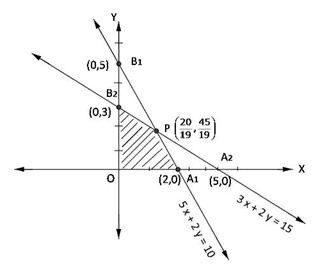
Region represented by 3x + 5y ≤ 15:
The line meets the coordinate axes at A2(5,0) and B2(0,3). By joining these points we obtain the line 3x + 5y = 15.
So, (0,0) satisfies the inequation 3x + 5y ≤ 15. Hence, the region containing the origin represents the solution set of the inequation 3x + 5y ≤ 15.
Region represented by 5x + 2y ≤ 10:
The line meets the coordinate axes at A1(2,0) and B1(0,5). By joining these points we obtain the line 5x + 2y = 10.
So, (0,0) satisfies the inequation 5x + 2y ≤ 10. Hence, the region containing the origin represents the solution set of the inequation 5x + 2y ≤ 10.
Region represented by x ≥ 0, y ≥ 0:
Since, every point in the first quadrant satisfies these inequations. So, the first quadrant is the region represented by the inequations x ≥ 0, y ≥ 0.
The coordinates of the corner points of shaded region are O(0,0), A(2,0), P(20/19, 45/19), B2(0,3)
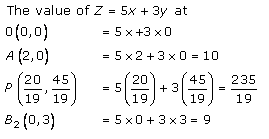
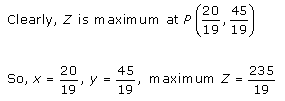
Q2.
Solution:
Firstly let us convert the given Inequations into equations, we get
2x + 3y = 13,
3x + y = 5,
x = 0,
y = 0
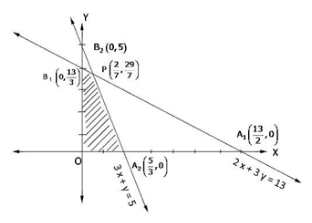
Region represented by 2x + 3y ≤ 13:
The line meets the coordinate axes at A1(13/2,0) and B1(0,13/3). By joining these points we obtain the line 2x + 3y = 13.
So, (0,0) satisfies the inequation 2x + 3y ≤ 13. Hence, the region containing the origin represents the solution set of the inequation 2x + 3y ≤ 13.
Region represented by 3x + y ≤ 5:
The line meets the coordinate axes at A2(5/3,0) and B2(0,5). By joining these points we obtain the line 3x + y = 5.
So, (0,0) satisfies the inequation 3x + y ≤ 5. Hence, the region containing the origin represents the solution set of the inequation 3x + y ≤ 5.
Region represented by x ≥ 0, y ≥ 0:
Since, every point in the first quadrant satisfies these inequations. So, the first quadrant is the region represented by the inequations x ≥ 0, y ≥ 0.
The coordinates of the corner points of shaded region are O(0,0), A(5/3,0), P(2/7, 29/7), B2(0,13/3)

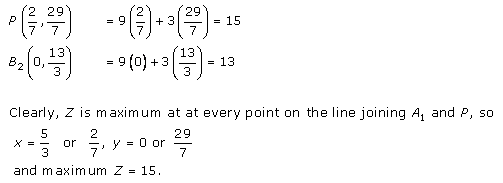
Q3.
Solution:
Firstly let us convert the given Inequations into equations, we get
4x + y = 20,
2x + 3y = 30,
x = 0,
y = 0
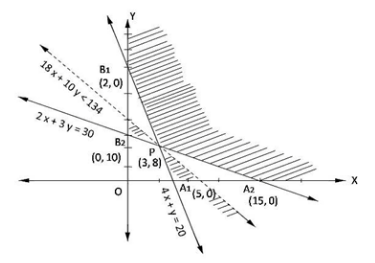
Region represented by 4x + y ≥ 20:
The line meets the coordinate axes at A1(5,0) and B1(0,20). By joining these points we obtain the line 4x + y = 20.
So, (0,0) satisfies the inequation 4x + y ≥ 20. Hence, the region containing the origin represents the solution set of the inequation 4x + y ≥ 20.
Region represented by 2x + 3y ≥ 30:
The line meets the coordinate axes at A2(15,0) and B2(0,10). By joining these points we obtain the line 2x + 3y = 30.
So, (0,0) satisfies the inequation 2x + 3y ≥ 30. Hence, the region containing the origin represents the solution set of the inequation 2x + 3y ≥ 30.
Region represented by x ≥ 0, y ≥ 0:
Since, every point in the first quadrant satisfies these inequations. So, the first quadrant is the region represented by the inequations x ≥ 0, y ≥ 0.
The coordinates of the corner points of shaded region are A2(15,0), P(3,8), B1(0,20)


It is clear that, x = 3 and y = 8 is optimal. Hence, Minimum value of Z is 134 at points (3,8).
Q4.
Solution:
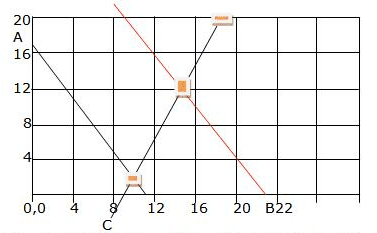

Let us plot these points, we get lines AB and CD.
We know that the feasible area is the unbounded area D-E-12
| Corner point | Value of Z = 50x + 30y |
| 10, 2 | 560 |
| 11.3, 17 | 1076.66 |
The maximum value of Z = 50x + 30y which occurs at x = 34/3, y = 17
Since we have an unbounded region as the feasible area plot 50x + 30y > 1076.66
The region D-F-B has common points with region D-E-12 the problem has no optimal maximum value.
Q5.
Solution:
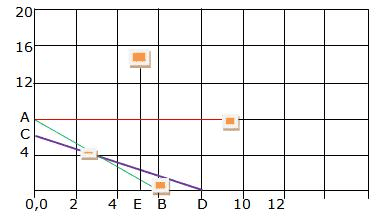
3x + 4y ≤ 24; when x = 0, y = 6 and when y = 0, x = 8, line AB.
8x + 6y ≤ 48; when x = 0, y = 8 and when y = 0, x = 6, line CD.
Let us plot these points, x ≤ 5 we get line EF and y ≤ 6 we get line AG.
We know that the feasible area is the unbounded area O, O-C-H-G-E
| Corner point | Value of Z = 4x + 3y |
| 0,0 | 0 |
| 0,6 | 18 |
| 3.4, 3.4 | 24 |
| 5, 1 | 23 |
| 5, 0 | 20 |
Access RD Sharma Solutions for Class 12 Maths Chapter 30 Exercise 3
EXERCISE 30.3
Q1.
Solution:
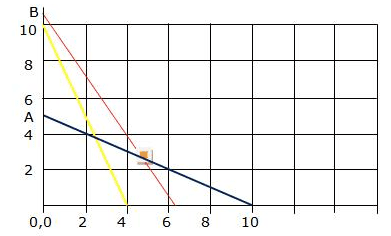
Let us consider x and y be number of 25gms of food packets, F1 and F2
Minimum cost of diet Z = 0.20x + 0.15y
Therefore the constraints are:
0.25x + 0.1y ≥ 1; when x = 0, y = 10 and y = 0, x = 4 10-4
0.75x + 1.5y ≥ 7.5; when x = 0, y = 5 and y = 0, x = 10 A-10
1.6x + 0.8y ≥ 10; when x = 0, y = 25/2 and y = 0, x = 25/4
The feasible region is the open region B-E-10
The minimum cost of the diet can be checked by finding the value of Z at corner points B, E and 10.
| Corner points | Value of Z = 20x + 15y |
| 0, 12.5 | 187.5 |
| 10, 0 | 200 |
| 5, 2.5 | 137.5 |
Since the feasible region is an open region so we plot 20x + 15y < 137.5, to check whether the resulting open half plane has any point common with the feasible region.
Since it has common points Z = 20x + 15y
Hence there is no optimal minimum value subject to the given constraints.
Q2.
Solution:
Let us consider the required quantity of food A and B be x and y units.
Given:
Costs of one unit of food A and B are Rs 4 and Rs 3 per unit.
So, cost of x unit of food A and y unit of food B = 4x and 3y.
Let Z be minimum total cost,
So, Z = 4x + 3y
First Constraint:
One unit of food A and B contain = 200 and 100 units of vitamins
So, x units of food A and y units of food B contain = 200x and 100y units of vitamins
Minimum requirement of vitamin = 4000 units
So,
200x + 100y ≥ 4000
2x + y ≥ 40
Second constraint:
One unit of food A and B contain = 1 and 2 units of minerals
So, x units of food A and y units of food B contain = x and 2y units of minerals
Minimum requirement of minerals = 50 units
So,
x + 2y ≥ 50
Third constraint:
One unit of food A and B contain = 40 calories each
So, x units of food A and y units of food B contain = 40x and 40y units of calories
Minimum requirement of calories = 1400 units
So,
40x + 40y ≥ 1400
2x + 2y ≥ 70
x + y ≥ 35
Hence, the required mathematical formulation of linear programming is:
Minimize Z = 4x + 3y
Subject to constraints
2x + y ≥ 40
x + 2y ≥ 50
x + y ≥ 35
Where, x, y ≥ 0
Now, region 2x + y ≥ 40:
The line 2x + y = 40 meets axes at A1(20, 0), B1(0, 40) region not containing origin represents 2x + y ≥ 40 as (0, 0) does not satisfy 2x + y ≥ 40.
Region x + 2y ≥ 50:
The line x + 2y = 50 meets axes at A2(50, 0), B2(0, 25) region not containing origin represents x + 2y ≥ 50 as (0, 0) does not satisfy x + 2y ≥ 50.
Region x + y ≥ 35:
The line x + y = 35 meets axes at A3(35, 0), B3(0, 35) region not containing origin represents x + y ≥ 35 as (0, 0) does not satisfy x + y ≥ 35.
Region x, y ≥ 0: it represents first quadrant in xy-plane.
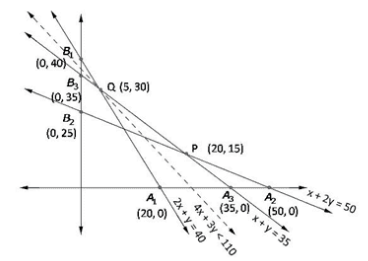
Unbounded shaded region A2 P Q B1 represents feasible region with corner points A2(50, 0), P(20,15), Q(5, 30), B1(0, 40)
The value of Z = 4x + 3y at
A2(50, 0) = 4(50) + 3(0) = 2000
P(20, 15) = 4(20) + 3(15) = 125
Q(5, 30) = 4(5) + 3(30) = 110
B1(0, 40) = 4(0) + 3(40) = 110
Hence, smallest value of Z = 110
Open half plane 4x + 3y < 110 has no point in common with feasible region
So, smallest value is the minimum value.
Quantity of food A = x = 5 units
Quantity of food B = y = 30 units
Minimum cost = Rs 110
Q3.
Solution:
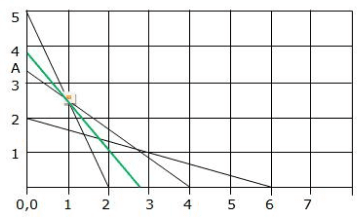
Let us consider x and y be units of food, F I and F II
The objective function is to minimize the function Z = 0.6x + y
Where,
10x + 4y ≥ 20; requirement of calcium, line 5-2
5x + 6y ≥ 20; requirement of protein, line A-4
2x + 6y ≥ 12; requirement of calories, line 2-6
The feasible region is the open unbounded region 5-F-E-6
The function 20x + 15y < 57.5 needs to be plotted to check if there are any common points. The green line shows that there are no common points.
So,
| Corner points | Value of Z = 0.6x + y |
| 0, 5 | 5 |
| F(1, 2.5) | 3.1 |
| E(2.67, 1.11) | 2.71 |
| 6, 0 | 3.6 |
The minimum cost occurs when Food I is 1 unit and Food II is 2.5 units.
Since it is an unbounded region plotting Z < 3.1 gives the green line which has no common points.
So, (1, 2.5) is aid to be a minimum point.
Q4.
Solution:
Let us consider the required quantity of food A and B be x and y units.
Given:
Costs of one unit of food A and B are 10paise per unit.
So, cost of x unit of food A and y unit of food B = 10x and 10y.
Let Z be minimum total cost,
So, Z = 10x + 10y
First Constraint:
One unit of food A and B contain = 0.12mg and 0.10mg of Thiamin
So, x units of food A and y units of food B contain = 0.12x and 0.10y mg of Thiamin
Minimum requirement of Thiamin = 0.5mg
So,
0.12x + 0.10y ≥ 0.5
12x + 10y ≥ 50
6x + 5y ≥ 25
Second constraint:
One unit of food A and B contain = 100 and 150 calories
So, x units of food A and y units of food B contain = 100x and 150y units of calories
Minimum requirement of calories = 600 units
So,
100x + 150y ≥ 600
2x + 3y ≥ 12
Hence, the required mathematical formulation of linear programming is:
Minimize Z = 10x + 10y
Subject to constraints
6x + 5y ≥ 25
2x + 3y ≥ 12
Where, x, y ≥ 0
Now, region 6x + 5y ≥ 25:
The line 6x + 5y = 25 meets axes at A1(25/6, 0), B1(0, 5) region not containing origin represents 6x + 5y ≥ 25 as (0, 0) does not satisfy 6x + 5y ≥ 25.
Region 2x + 3y ≥ 12:
The line 2x + 3y = 12 meets axes at A2(6, 0), B2(0, 4) region not containing origin represents 2x + 3y ≥ 12 as (0, 0) does not satisfy 2x + 3y ≥ 12.
Region x, y ≥ 0: it represents first quadrant in xy-plane.
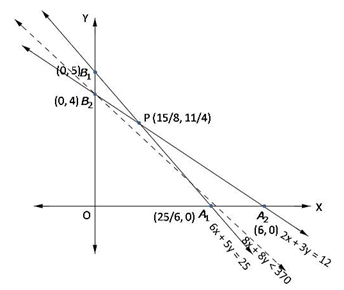
Unbounded shaded region A2 P B1 represents feasible region with corner points A2(6, 0), P(15/8,11/4), B1(0, 5)
The value of Z = 10x + 10y at
A2(6, 0) = 10(6) + 10(0) = 60
P(15/8, 11/4) = 10(15/8) + 10(11/4) = 370/8 = 46 ¼
B1(0, 5) = 10(0) + 10(5) = 50
Hence, smallest value of Z = 46 ¼
Open half plane 10x + 10y < 370/8 has no point in common with feasible region
So, smallest value is the minimum value.
Required quantity of food A = x = 15/8 units
Required quantity of food B = y = 11/4 units
Minimum cost = Rs 46. 25
Q5.
Solution:
Let us consider the required quantity of food A and B be x and y kg.
Given:
Costs of one kg of food A and B are Rs 5 and Rs 8 kg.
So, cost of x kg of food A and y kg of food B = 5x and 8y.
Let Z be minimum total cost,
So, Z = 5x + 8y
First Constraint:
One kg of food A and B contain = 1 and 2 units of vitamin A
So, x kg of food A and y kg of food B contain = x and 2y kg of vitamin A
Minimum requirement of vitamin A = 6 units
So,
x + 2y ≥ 6
Second constraint:
One kg of food A and B contain = 1 unit of Vitamin B each
So, x kg of food A and y kg of food B contain = x and y units of vitamin B
Minimum requirement of vitamin B = 7 units
So,
x + y ≥ 7
Third constraint:
One kg of food A and B contain = 1 and 3 units of vitamin C
So, x kg of food A and y kg of food B contain = x and 3y units of vitamin C
Minimum requirement of vitamin C = 11 units
So,
x + 3y ≥ 11
Fourth constraint:
One kg of food A and B contain = 2 and 1 units of vitamin D
So, x kg of food A and y kg of food B contain = 2x and y units of vitamin D
Minimum requirement of vitamin D = 9 units
So,
2x + y ≥ 9
Hence, the required mathematical formulation of linear programming is:
Minimize Z = 5x + 8y
Subject to constraints
x + 2y ≥ 6
x + y ≥ 7
x + 3y ≥ 11
2x + y ≥ 9
Where, x, y ≥ 0
Now, region x + 2y ≥ 6:
The line x + 2y = 6 meets axes at A1(6, 0), B1(0, 3) region not containing origin represents x + 2y ≥ 6 as (0, 0) does not satisfy x + 2y ≥ 6.
Region x + y ≥ 7:
The line x + y = 7 meets axes at A2(7, 0), B2(0, 7) region not containing origin represents x + y ≥ 7 as (0, 0) does not satisfy x + y ≥ 7.
Region x + 3y ≥ 11:
The line x + 3y ≥ 11 meets axes at A3(11, 0), B3(0, 11/3) region not containing origin represents x + 3y ≥ 11 as (0, 0) does not satisfy x + 3y ≥ 11.
Region 2x + y ≥ 9:
The line 2x + y = 9 meets axes at A4(9/2, 0), B4(0, 9) region not containing origin represents 2x + y ≥ 9 as (0, 0) does not satisfy 2x + y ≥ 9.
Region x, y ≥ 0: it represents first quadrant in xy-plane.
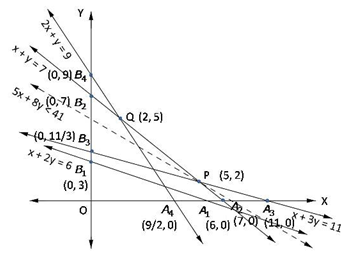
Unbounded shaded region A2 P Q B4 represents feasible region with corner points A3(11, 0), P(5, 2), Q(2, 5), B4(0, 9)
The value of Z = 5x + 8y at
A3(11, 0) = 5(11) + 8(0) = 55
P(5, 2) = 5(5) + 8(2) = 41
Q(2, 5) = 5(2) + 8(5) = 50
B4(0, 9) = 5(0) + 8(9) = 72
Hence, smallest value of Z = 41
Open half plane 5x + 8y < 41 has no point in common with feasible region
So, smallest value is the minimum value.
Last cost of mixture = Rs 41
Access RD Sharma Solutions for Class 12 Maths Chapter 30 Exercise 4
EXERCISE 30.4
Q1.
Solution:
Let us consider a young man drive x km at a speed of 25km/hr and y km at a speed of 40km/hr.
Let Z be the total distance travelled by young man.
So, Z = x + y
First constraint:
When speed is 25km/hr, the young man spends = Rs 2 per km
When speed is 40km/hr, the young man spends = Rs 5 per km
So,
Expenses on x km and y km = Rs 2x and Rs 5y
But young man has only Rs 100
So, 2x + 5y ≤ 100
Second constraint:
Time taken to travel x km = Distance/speed
= x/25 hr
Time taken to travel y km = Distance/speed
= y/40 hr
It is given that, 1hr to travel,
So, x/25 + y/40 ≤ 1
40x + 25y ≤ 1000
8x + 5y ≤ 200
Hence, the required mathematical formulation of linear programming is:
Minimize Z = x + y
Subject to constraints
2x + 5y ≤ 100
8x + 5y ≤ 200
Where, x, y ≥ 0
Now, region 2x + 5y ≤ 100:
The line 2x + 5y = 100 meets axes at A1(50, 0), B1(0, 20) region containing origin represents 2x + 5y ≤ 100 as (0, 0) satisfies 2x + 5y ≤ 100.
Region 8x + 5y ≤ 200:
The line 8x + 5y = 200 meets axes at A2(25, 0), B2(0, 40) region containing origin represents 8x + 5y ≤ 200 as (0, 0) satisfies 8x + 5y ≤ 200.
Region x, y ≥ 0: it represents first quadrant in xy-plane.
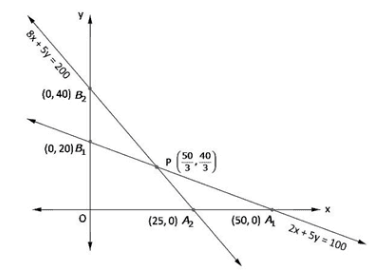
Shaded region O A2 P B1 represents feasible region.
Point P(50/3, 40/3) is obtained by solving 8x + 5y = 200, 2x + y = 100
The value of Z = x + y at
O(0, 0) = 0 + 0 = 0
A2(25, 0) = 25 + 0 = 25
P(50/3, 40/3) = 50/3 + 40/3 = 30
B1(0, 20) = 0 + 20 = 20
Hence, maximum value of Z = 30 at x = 50/3, y = 40/3
Distance travelled at speed of 25km/hr = 50/3 km
And at speed of 40 km/hr = 40/3 km
So maximum distance = 30 km
Q2.
Solution:
Let us consider the required quantity of items be A and B.
Given:
Profits on one item A and B = Rs 6 and Rs 4
So, profits on x items of type A and y items on type B = 6x and 4y
Let the total profit be Z,
Z = 6x + 4y
First constraint:
Machine I works 1 hour and 2hours on item A and B
So, x no. of item A and y no. of item B = x hour and 2y hours on machine I
Machine I works at most = 12 hours
x + 2y ≥ 12
Second constraint:
Machine II works 2 hours and 1hour on item A and B
So, x no. of item A and y no. of item B = 2x hours and y hours on machine II
Machine II works maximum of = 12 hours
2x + y ≥ 12
Third constraint:
Machine III works 1 hour and 5/4hour on item A and B
So, x no. of item A and y no. of item B = x hours and 5/4y hours on machine III
Machine III works at least = 5 hours
x + 5/4y ≥ 5
4x + 5y ≥ 20
Hence, the required mathematical formulation of linear programming is:
Minimize Z = 6x + 4y
Subject to constraints
x + 2y ≥ 12
2x + y ≥ 12
4x + 5y ≥ 20
Where, x, y ≥ 0
Now, region x + 2y ≥ 12:
The line x + 2y = 12 meets axes at A1(12, 0), B1(0, 6) region containing origin represents x + 2y ≥ 12 as (0, 0) satisfies x + 2y ≥ 12.
Region 2x + y ≥ 12:
The line 2x + y = 12 meets axes at A1(6, 0), B1(0, 12) region containing origin represents 2x + y ≥ 12 as (0, 0) satisfies 2x + y ≥ 12.
Region 4x + 5y ≥ 20:
The line 4x + 5y = 20 meets axes at A3(5, 0), B3(0, 4) region not containing origin represents 4x + 5y ≥ 20 as (0, 0) does not satisfy 4x + 5y ≥ 20.
Region x, y ≥ 0: it represents first quadrant in xy-plane.
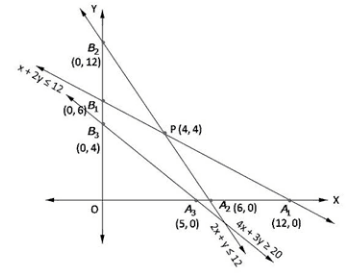
Shaded region A2 A3 P B3 B1 represents feasible region.
The value of Z = 6x + 4y at
A2(6, 0) = 6(6) + 4(0) = 36
A3(5, 0) = 6(5) + 4(0) = 30
B3(0, 4) = 6(0) + 4(4) = 16
B2(0, 6) = 6(0) + 4(6) = 24
P(4,4) = 6(4) + 4(4) = 40
Hence, maximum value of Z = 40 at x = 4, y = 4
Required number of product A =4, product B = 4
So maximum profit = Rs 40
Q3.
Solution:
Let us consider tailor A and B work for x and y days.
Given:
Tailor A and B earn = Rs 15 and Rs 20
So, tailor A and B earn is x and y days = Rs 15x and 20y
Let the total maximum profit be Z which gives minimum labour cost,
Z = 15x + 20y
First constraint:
Tailor A and B stitches = 6 and 10 shirts in a day
So, tailor A and B can stitch = 6x and 10y shirts in a day
But, tries to produce atleast = 60 shirts
So, 6x + 10y ≥ 60
3x + 5y ≥ 30
Second constraint:
Tailor A and B stitches = 4 pants each in a day
So, tailor A and B can stitch = 4x and 4y pants in a day
But, tries to produce atleast = 32 pants
So, 4x + 4y ≥ 32
x + y ≥ 8
Hence, the required mathematical formulation of linear programming is:
Minimize Z = 15x + 20y
Subject to constraints
3x + 5y ≥ 30
x + y ≥ 8
Where, x, y ≥ 0
Now, region 3x + 5y ≥ 30:
The line 3x + 5y = 30 meets axes at A1(10, 0), B1(0, 6) region not containing origin represents 3x + 5y ≥ 30 as (0, 0) does not satisfy 3x + 5y ≥ 30.
Region x + y ≥ 8:
The line x + y = 8 meets axes at A2(8, 0), B2(0, 8) region not containing origin represents x + y ≥ 8 as (0, 0) does not satisfy x + y ≥ 8.
Region x, y ≥ 0: it represents first quadrant in xy-plane.
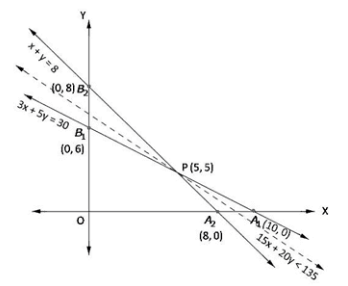
Unbounded shaded region A1 P B2 represents feasible region with corner points A1(10, 0), P(5, 3), B2(0, 8)
The value of Z = 15x + 20y at
A1(10, 0) = 15(10) + 20(0) = 150
P(5, 3) = 15(5) + 20(3) = 135
B2(0, 8) = 15(0) + 20(8) = 160
Hence, smallest value of Z = 135
Open half plane 15x + 20y < 135 has no point in common with feasible region
So, smallest value is the minimum value.
Z = 135, at x = 5, y = 3
Therefore, tailor A should work for 5 days and B should work for 3 days.
Q4.
Solution:
Let us consider the factory manufactures x screws of type A and y screws of type B per day.
So, x ≥ 0 and y ≥ 0
| Screw A | Screw B | Availability | |
| Automatic Machine (min) | 4 | 6 | 4 x 60 = 120 |
| Hand operated Machine (min) | 6 | 3 | 4 x 60 = 120 |
The profit on package of screws A and screws B is Rs 7 and Rs 10.
So the constraints are:
4x + 6y ≤ 240
6x + 3y ≤ 240
Total profit, Z = 7x + 10y
Hence, the required mathematical formulation of linear programming is:
Minimize Z = 7x + 10y
Subject to constraints
4x + 6y ≤ 240
6x + 3y ≤ 240
Where, x, y ≥ 0
The feasible region obtained by the constraints is:
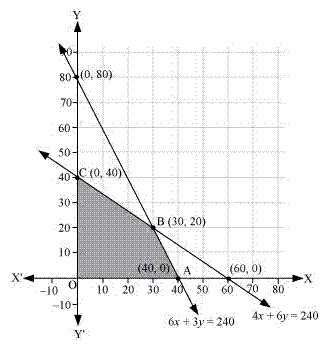
The corner points are A(40, 0), B(30, 20) and C(0, 40)
So the value of Z at these corner points is:
| Corner point | Z = 7x + 10y | |
| A(40, 0) | 280 | |
| B(30, 20) | 410 | maximum |
| C(0, 40) | 400 |
Hence, the maximum value of Z = 410 at B(30, 20).
So, the factory should produce 30 packages of screws A and 20 packages of screws B to get the maximum profit of Rs 410.
Q5.
Solution:
Let us consider the required number of belt A and belt B be x and y.
Given:
Profits on belt A and B = Rs 2 and Rs 1.50 per belt
So, profits on x belts of type A and y belts on type B = 2x and 1.5y
Let the total profit be Z,
Z = 2x + 1.5y
First constraint:
Each belt of type A requires twice as much as belt B.
Each belt of type B requires = 1 hour to make, so A requires = 2 hours
So for x and y belts of type A and B requires = 2x and y hours to make
Total time available is equal to production of 1000 belts B = 1000 hours
2x + y ≤ 1000
Second constraint:
It is given that, supply of leather for = 800 belts per day for both A and B
So, x + y ≤ 800
Third constraint:
It is given that, buckles available for A = 400 and
Buckles available for B = 700
So, x ≤ 400
y ≤ 700
Hence, the required mathematical formulation of linear programming is:
Maximize Z = 2x + 1.5y
Subject to constraints
2x + y ≤ 1000
x + y ≤ 800
x ≤ 400
y ≤ 700
Where, x, y ≥ 0
Now, region 2x + y ≤ 1000:
The line 2x + y = 1000 meets axes at A1(500, 0), B1(0, 1000) region containing origin represents 2x + y ≤ 1000 as (0, 0) satisfies 2x + y ≤ 1000.
Region x + y ≤ 800:
The line x + y = 800 meets axes at A2(800, 0), B2(0, 800) region containing origin represents x + y ≤ 800 as (0, 0) satisfies x + y ≤ 800.
Region x ≤ 400:
The line x ≤ 400 is parallel to y-axis and meets x-axis at A3(400, 0) region containing origin represents x ≤ 400 as (0, 0) satisfies x ≤ 400.
Region y ≤ 400:
The line y ≤ 700 is parallel to x-axis and meets y-axis at B3(0, 700) region containing origin represents y ≤ 700 as (0, 0) satisfies y ≤ 700.
Region x, y ≥ 0: it represents first quadrant in xy-plane.
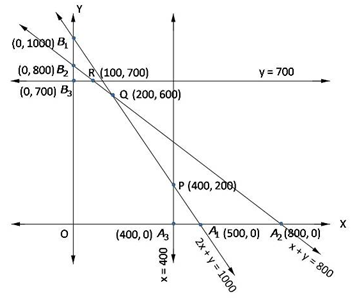
Shaded region O A3 P Q R B3 represents feasible region.
Point P is obtained by intersection of x + y = 800, 2x + y = 1000,
R is not point of intersection of y = 700, x + y = 800.
The value of Z = 2x + 1.5y at
O(0, 0) = 2(0) + 1.5(0) = 0
A3(400, 0) = 2(400) + 1.5(0) = 800
P(400, 200) = 2(400) + 1.5(200) = 1100
Q(200, 600) = 2(200) + 1.5(600) = 1300
R(100, 700) = 2(100) + 1.5(700) = 1250
B3(0, 700) = 2(0) + 1.5(700) = 1050
Hence, maximum value of Z = 1300 at x = 200, y = 600
Required no. of belt A = 200,
Required no. of belt B = 600,
So maximum profit = Rs 1300
Access RD Sharma Solutions for Class 12 Maths Chapter 30 Exercise 5
EXERCISE 30.5
Q1.
Solution:
Let us consider godown A supply x and y quintals of grain to the shops D and E.
Then, (100 – x – y) will be supplied to shop F.
The requirement at shop D is 60 quintals since, x quintals are transported from godown A.
Therefore, the remaining (60 − x) quintals will be transported from godown B.
Similarly, (50 − y) quintals and 40 − (100 − x − y) i.e. (x + y − 60) quintals will be transported from godown B to shop E and F respectively.
Here is the diagrammatic representation of the given problem:
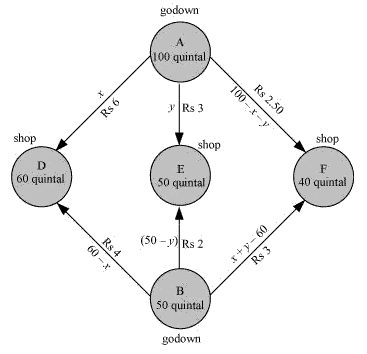
x ≥ 0 , y ≥ 0 and 100 – x – y ≥ 0
⇒ x ≥ 0 , y ≥ 0 , and x + y ≤ 100
60 – x ≥ 0 , 50 – y ≥ 0 , and x + y – 60 ≥ 0
⇒ x ≤ 60 , y ≤ 50 , and x + y ≥ 60
Total transportation cost Z is given by,
Z = 6x + 3y + 2.5(100 – x – y) + 4(60 – x) + 2(50 – y) + 3( x + y – 60)
= 6x + 3y + 250 – 2.5x – 2.5y + 240 – 4x + 100 – 2y + 3x + 3y – 180
= 2.5x + 1.5y + 410
Hence, the required mathematical formulation of linear programming is:
Minimize Z = 2.5x + 1.5y + 410
subject to the constraints,
x + y ≤ 100
x ≤ 60
y ≤ 50
x + y ≥ 60
x, y ≥ 0
The feasible region obtained by the system of constraints is:
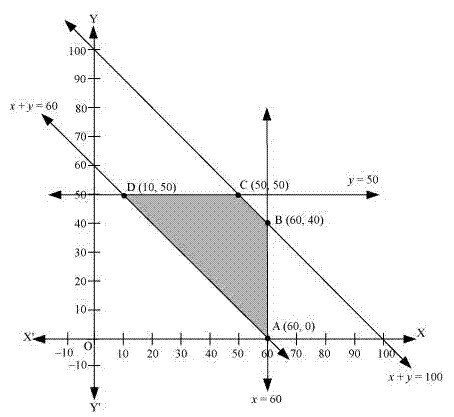
The corner points are A(60, 0), B(60, 40), C(50, 50), and D(10, 50).
The values of Z at these corner points are as follows.
| Corner point | Z = 2.5x + 1.5y + 410 |
| A (60, 0) | 560 |
| B (60, 40) | 620 |
| C (50, 50) | 610 |
| D (10, 50) | 510 -> minimum |
Hence, the minimum value of Z is 510 at D (10, 50).
Thus, the amount of grain transported from A to D, E, and F is 10 quintals, 50 quintals, and 40 quintals respectively.
From B to D, E, and F is 50 quintals, 0 quintals, and 0 quintals respectively.
The minimum cost is Rs 510.
Q2.
Solution:
The diagrammatic representation of the given problem:
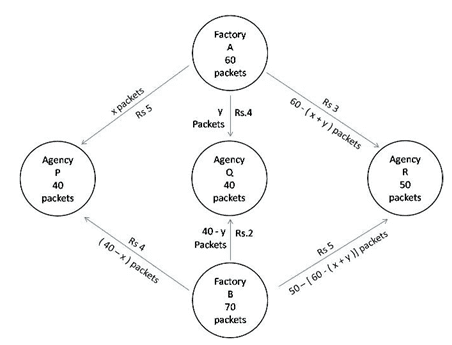
Let x and y packets be transported from factory A to the agencies P and Q respectively.
Then, [60 − (x + y)] packets be transported to the agency R.
First constraint:
x, y ≥ 0 and
Second constraint:
60 − (x + y) ≥ 0
(x + y) ≤ 60
The requirement at agency P is 40 packets. Since, x packets are transported from factory A,
Therefore, the remaining (40 − x) packets are transported from factory B.
Similarly, (40 − y) packets are transported by B to Q and 50− [60 − (x + y)] i.e. (x + y − 10) packets will be transported from factory B to agency R respectively.
Number of packets cannot be negative.
Therefore,
Third constraint:
40 – x ≥ 0
=> x ≤ 40
Fourth constraint:
40 – y ≥ 0
=> y ≤ 40
Fifth constraint:
x + y – 10 ≥ 0
=> x + y ≥ 10
So, costs of transportation of each packet from factory A to agency P, Q, R are Rs 5, 4, 3.
Costs of transportation of each packet from factory B to agency P, Q, R are Rs 4, 2, 5.
Let total cost of transportation be Z.
Z = 5x + 4y + 3[60 – x + y] + 4(40 – x) + 2(40 – y) + 5(x + y – 10]
= 3x + 4y + 10
Hence, the required mathematical formulation of linear programming is:
Minimize Z = 3x + 4y + 370
subject to constraints,
x + y ≤ 60
x ≤ 40
y ≤ 40
x + y ≥ 10
where, x, y ≥ 0
Let us convert inequations into equations as follows:
x + y = 60, x = 40, y = 40, x + y = 10, x = 0 and y = 0
Region represented by x + y ≤ 60:
The line x + y = 60 meets the coordinate axes at A1(60, 0) and B1(0, 60) respectively. Region containing origin represents x + y ≤ 60 as (0, 0) satisfies x + y ≤ 60.
Region represented by x ≤ 40:
The line x = 40 is parallel to y-axis, meets x-axis at A2(40, 0). Region containing origin represents x ≤ 40 as (0, 0) satisfies x ≤ 40.
Region represented by y ≤ 40:
The line y = 40 is parallel to x-axis, meets y-axis at B2(0, 40). Region containing origin represents y ≤ 40 as (0, 0) satisfies y ≤ 40.
Region represented by x + y ≥ 10:
The line x + y = 10 meets the coordinate axes at A2(10, 0) and B3(0, 10) respectively. Region not containing origin represents x + y ≥ 10 as (0, 0) does not satisfy x + y ≥ 10.
Shaded region A3 A2 P Q B2 B3 represents feasible region.
Point P(40, 20) is obtained by solving x = 40 and x + y = 60
Point Q(20, 40) is obtained by solving y = 40 and x + y = 60
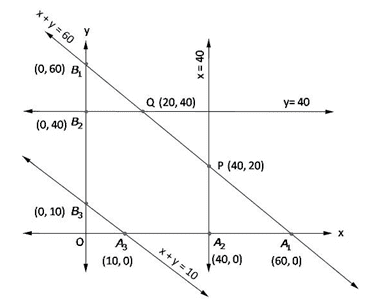
The value of Z = 3x + 4y + 370 at
A3(10, 0) = 3(10) + 4(0) + 370 = 400
A2(40, 0) = 3(40) + 4(0) + 370 = 490
P(40, 20) = 3(40) + 4(20) + 370 = 570
Q(20, 40) = 3(20) + 4(40) + 370 = 590
B2(0, 40) = 3(0) + 4(40) + 370 = 530
B3(0, 10) = 3(0) + 4(10) + 370 = 410
Hence, minimum value of Z = 400 at x = 10, y = 0
So, from A -> P = 10 packets
From A -> Q = 0 packets
From A -> R = 50 packets
From B -> P = 30 packets
From B -> Q = 40 packets
From B -> R = 0 packets
Therefore, minimum cost = Rs 400